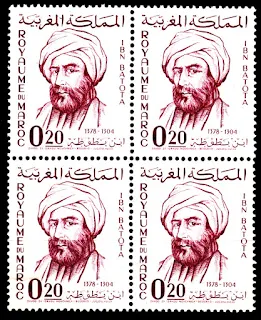MOROCCO POST (Royaume du Maroc) in 1963 issued a series of three stamps honouring Medieval Scholars of the Maghreb or Berber world in northwest Africa. The subjects of three twenty centime stamps were geographer Al-Idrissi, explorer Ibn Battuta and historian and sociologist Ibn Khaldoun. Shown here are mint and unmounted block issues of each scholar.
Ibn Battuta (1304-1368/1369) was a Muslim Moroccan scholar and explorer who travelled extensively in Afro-Eurasia, largely in the lands of Dar al-Islam, travelling more than any other explorer in pre-modern history, totalling around 117,000 km (72,000 miles), surpassing Zheng He with about 50,000 km (30,000 miles) and Marco Polo with 24,000 km (15,000 miles). Over a period of thirty years, Ibn Battuta visited most of southern Eurasia, including Central Asia, Southeast Asia, South Asia, China and the Iberian Peninsula. Near the end of his life, he dictated an account of his journeys, titled A Gift to Those Who Contemplate the Wonders of Cities and the Marvels of Travelling, but commonly known as The Rihla.
Ibn Khaldun or Abū Zayd ‘Abd ar-Raḥmān ibn Muḥammad ibn Khaldūn al-Ḥaḍramī (1332-1406) was an Arab sociologist, philosopher and historian who has been described as the precursive founder of the proto-disciplines that would become historiography, sociology, economics, and demography. Niccolò Machiavelli of the Renaissance, Georg Wilhelm Friedrich Hegel and 19th-century European scholars widely acknowledged the significance of his works and considered Ibn Khaldun to be one of the greatest philosophers of the Middle Ages.
His best-known book, the Muqaddimah or Prolegomena ("Introduction"), which he wrote in six months as he states in his autobiography, influenced 17th-century Ottoman historians like Kâtip Çelebi, Ahmed Cevdet Pasha and Mustafa Naima, who used its theories to analyze the growth and decline of the Ottoman Empire. Ibn Khaldun interacted with Tamerlane, the founder of the Timurid Empire.
Al-Idrisi or Abu Abdullah Muhammad al-Idrisi al-Qurtubi al-Hasani as-Sabti (1100 – 1165), was an Arab Muslim geographer, cartographer and Egyptologist who for some time lived in Palermo, Sicily at the court of King Roger II. Muhammed al-Idrisi was born in Ceuta then belonging to the Almoravids. He created the Tabula Rogeriana, one of the most advanced medieval world maps.
The Tabula Rogeriana, drawn by al-Idrisi for Roger II of Sicily in 1154, was at the time one of the most advanced medieval world maps.
Source: Wikipedia



No comments:
Post a Comment